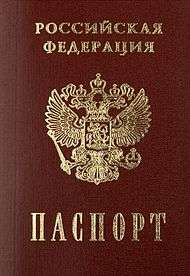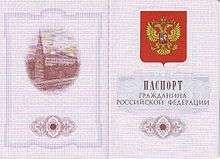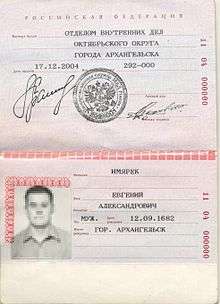Internal passport of Russia
The Internal Russian passport (officially in Russian: Паспорт гражданина Российской Федерации, commonly referred to as внутренний паспорт, общегражданский паспорт) is a mandatory identity document for all Russian citizens residing in Russia who are aged 14 or over. The Internal Russian passport is an internal passport used for travel and identification purposes within Russia, which is distinct from the International Russian passport used by Russian citizens to travel in and out of Russian borders.
| Internal Russian passport | |
|---|---|
 Cover of the Internal Russian passport | |
| Type | Internal passport |
| Issued by | |
| First issued | 2007 |
| Purpose | Identification, proof of residence, proof of citizenship |
| Valid in | and for travel to: |
| Eligibility | Russian Federation citizenship, and age 14+ |
| Expiration | Renewed at age 20 and 45 |
| Cost | 300 ₽, 1500 ₽ in case of loss or damage |
After the breakup of the Soviet Union in 1991, the Soviet Union internal passport continued to be issued until 1997, when it was replaced by the Russian internal passport. The current Russian internal passports were first issued in 2007.[1]
The Russian government is planning to replace the Internal Passport with a biometric, credit card size card. The Universal electronic card issued between 2013 and 2016 was planned to replace the Russian Internal passport as the sole national identity document for Russian citizens but was scrapped in early 2017.
History
Background
After the liberation of the serfs the peasant was declared by the law as attached to the former tax-paying estate or having a rural station (sel’skoe sostoianie). Membership in the peasant community, the legally mandatory reception of allotment land, arrears and collective responsibility characterized this rural station, and the passport system and residence permit enforced it. The internal passport was issued only in the local district office and was valid for the entire empire while the identification card (Russian: Свидетельство) was valid only within 30 Verst (approximately thirty kilometers) of the place of registration, were critical for obtaining work outside a farmer own district.[2]
Modern period
In 1992, passports – or other photo identification documents – became necessary to board a train. Train tickets started to bear passenger names, allegedly, as an effort to combat speculative reselling of the tickets.
On 9 December 1992, special pages were introduced which were affixed in Soviet passports, certifying that the bearer of the passport was a citizen of Russia. These pages were optional unless travelling to the other former Soviet republics which continued to accept Soviet passports; for other occasions, other proofs of citizenship were accepted as well. Issuance of the pages continued until the end of 2002.
On 8 July 1997, the currently-used design of the Russian internal passport was introduced.[3] Unlike the Soviet passports, which had three photo pages, the new passports only have one. A passport is first issued at the age of 14, and then replaced upon reaching the ages of 20 and 45. The text in the passports is in Russian, but passports issued in autonomous entities may, on the bearer's request, contain an additional page duplicating all data in one of the official local languages.
A deadline for exchanging old passports for the new ones was initially set at year-end of 2001, but then extended several times and finally set at 30 June 2004. The government had first regulated that having failed to exchange one's passport would constitute a punishable violation. However, the Supreme Court ruled to the effect that citizens cannot be obliged to exchange their passports. The Soviet passports ceased to be valid as means of personal identification since mid-2004, but it is still legal (though barely practical) to have one.
The propiska was formally abandoned soon after adoption of the current Constitution in 1993, and replaced with "residency registration" which, in principle, was simply notification of one's place of residence.
Nevertheless, under the new regulations, permanent registration records are stamped in citizens' internal passports just as were propiskas. This has led to the widespread misconception that registration was just a new name for the propiska; many continue to call it "propiska". This misconception is partly reinforced by the fact that the existing rules for registration make it an onerous process, dependent on the consent of landlords, which effectively prevents tenants of flats from registering.
Internal Russian passports are issued only inside the country. Russian citizens who live abroad can get internal passport only if they visit Russia, i.e., it is not possible to get internal passport in the Russian consulate abroad. In practice, Russian citizens who live abroad often do not get new internal passports at all, as the law allows them to prove their identity with an international Russian passport (travel document).
Description


Each passport has a data page and a signature page. A data page has a visual zone which contains a photograph of the passport holder, data about the passport, and data about the holder:
- Surname
- Given name and patronymic
- Sex
- Date of birth
- Place of birth
Special mentions shall be made in the passport:
- on the registration of a citizen within a community/at a specific address and on removal from the registration records;
- on the military conscription of citizens who have attained 18 years of age;
- on the registration and termination of a marriage;
- for children under 14 years of age;
- for any previously issued basic identity documents of a citizen of the Russian Federation on the territory of the Russian Federation;
- for the extradition of the main documents of identity of the citizen of the Russian Federation outside the Russian Federation – only about valid ones at the time mention is made.
At the citizen's request, the passport may also include:
- the holder's blood type and the Rh factor (added by the medical facility where the citizen's blood type and Rh were tested, for example after a blood transfusion or donation);
- the holder's tax identification number.
Passport validity:
- Issued at or after 14 years of age – valid until the age of 20;
- Issued at or after 20 years of age – valid until the age of 45;
- Issued at or after 45 years of age – valid in perpetuity.
Upon reaching the age of 20 and 45, the passport must be replaced within 30 days after birthday. While undergoing military conscription, the passport can be issued or replaced at their place of residence at the end of the set period of military service. If a citizen is imprisoned, administration of a penal entity should return passport or render obtainment of a new one upon punishment is complete.
Replacement with identity cards
In November 2010 the Ministry of Internal Affairs announced the cancellation of internal passports with the aim of replacing them with plastic identity cards or driver's licenses by 2025. Country-wide replacement was postponed until 15 March 2018 not to interfere with 2016 Duma election [4] and then until 2022.
See also
- Identity card of the Russian Armed Forces
- Visa requirements for Russian citizens
- Russian passport
- Passport system in the Soviet Union
- Migration card
- Propiska in the Soviet Union
- Wolf ticket (Russia)
- 101st kilometre
- Closed cities
- Internal passport
- Real ID Act United States
References
- "Russian passport history (PDF)" (PDF). Archived from the original (PDF) on 2017-04-04. Retrieved 2017-04-04.
- Bradley, p. 107
- Decree of the President of the Russian Federation from 13.03.1997 N 232 ‘About main identity document of the citizen of the Russian Federation on the territory of the Russian Federation’ (Указ Президента РФ от 13.03.1997 №232 Об основном документе удостоверяющем личность гражданина Российской Федерации на территории Российской Федерации).
- Russian Federal Government Decree №315 from 16.04.2016 (Russian)